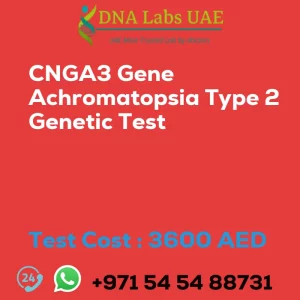Nx GEN SEQUENCING MICROPHTHALMIA ANOPHTHALMIA COLOBOMA SPECTRUM Test
Test Name: Nx GEN SEQUENCING MICROPHTHALMIA ANOPHTHALMIA COLOBOMA SPECTRUM Test
Components: ABCB6, ALDH1A3, BCOR, BMP4, CHD7, ERCC1, ERCC2, ERCC5, ERCC6, FOXE3, FOXL2, FRAS1, FREM1, FREM2, GDF3, GDF6, GJA1, GRIP1, HCCS, HESX1, HMGB3, HMX1, MAB21L2, MFRP, NAA10, NDP, OCRL, OTX2, PAX2, PAX6, PRSS56, PXDN, RAB18, RAB3GAP1, RAB3GAP2, RARB, RAX, RBP4, SALL2, SALL4, SHH, SIX3, SIX6, SMOC1, SOX2, STRA6, TBC1D20, TENM3, TFAP2A, VAX1, VSX2
Price: 5730.0 AED
Sample Condition: Submit 10 mL (5 mL min.) whole blood from 2 Lavender Top (EDTA) tubes. Ship refrigerated. DO NOT FREEZE. Duly filled Whole Exome Sequencing Consent Form (Form 37) is mandatory.
Report Delivery: Sample Daily by 9 am; Report 45 Working days
Method: NGS, Sanger sequencing
Test type: Defects in Eye
Doctor: Ophthalmologist
Test Department: MOLECULAR DIAGNOSTICS
Pre Test Information: Duly filled Whole Exome Sequencing Consent Form (Form 37) is mandatory.
Test Details
The Nx Gen Sequencing Micropthalmia/Anophthalmia/Coloboma Spectrum Test is a genetic test that can identify mutations or changes in genes associated with the development of eye abnormalities. These abnormalities can include microphthalmia (small eyes), anophthalmia (absence of one or both eyes), and coloboma (a gap or hole in one or more structures of the eye).
The test uses next-generation sequencing technology to analyze a panel of genes that have been linked to these eye abnormalities. The genes analyzed may vary depending on the specific version of the test being used, but typically include genes such as PAX6, SOX2, OTX2, and CHD7.
By identifying genetic mutations or changes, the test can provide information about the underlying cause of an individual’s eye abnormality. This information can be useful for diagnosis, treatment, and genetic counseling.
The test is typically performed on a blood or saliva sample, and results are usually available within a few weeks. It is important to note that not all cases of eye abnormalities are caused by genetic mutations, and the test may not identify a cause in every case.
| Test Name | Nx GEN SEQUENCING MICROPHTHALMIA ANOPHTHALMIA COLOBOMA SPECTRUM Test |
|---|---|
| Components | ABCB6, ALDH1A3, BCOR, BMP4, CHD7, ERCC1, ERCC2, ERCC5, ERCC6, FOXE3, FOXL2, FRAS1, FREM1, FREM2, GDF3, GDF6, GJA1, GRIP1, HCCS, HESX1, HMGB3, HMX1, MAB21L2, MFRP, NAA10, NDP, OCRL, OTX2, PAX2, PAX6, PRSS56, PXDN, RAB18, RAB3GAP1, RAB3GAP2, RARB, RAX, RBP4, SALL2, SALL4, SHH, SIX3, SIX6, SMOC1, SOX2, STRA6, TBC1D20, TENM3, TFAP2A, VAX1, VSX2 |
| Price | 5730.0 AED |
| Sample Condition | Submit 10 mL (5 mL min.) whole blood from 2 Lavender Top (EDTA) tubes. Ship refrigerated. DO NOT FREEZE. Duly filled Whole Exome Sequencing Consent Form (Form 37) is mandatory. |
| Report Delivery | Sample Daily by 9 am; Report 45 Working days |
| Method | NGS, Sanger sequencing |
| Test type | Defects in Eye |
| Doctor | Ophthalmologist |
| Test Department: | MOLECULAR DIAGNOSTICS |
| Pre Test Information | Duly filled Whole Exome Sequencing Consent Form (Form 37) is mandatory. |
| Test Details |
The Nx Gen Sequencing Micropthalmia/Anophthalmia/Coloboma Spectrum Test is a genetic test that can identify mutations or changes in genes associated with the development of eye abnormalities. These abnormalities can include microphthalmia (small eyes), anophthalmia (absence of one or both eyes), and coloboma (a gap or hole in one or more structures of the eye). The test uses next-generation sequencing technology to analyze a panel of genes that have been linked to these eye abnormalities. The genes analyzed may vary depending on the specific version of the test being used, but typically include genes such as PAX6, SOX2, OTX2, and CHD7. By identifying genetic mutations or changes, the test can provide information about the underlying cause of an individual’s eye abnormality. This information can be useful for diagnosis, treatment, and genetic counseling. The test is typically performed on a blood or saliva sample, and results are usually available within a few weeks. It is important to note that not all cases of eye abnormalities are caused by genetic mutations, and the test may not identify a cause in every case. |







